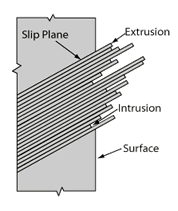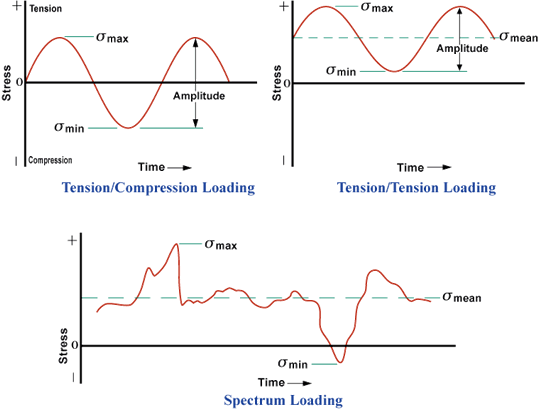Fatigue Properties
Fatigue cracking is one of the primary damage mechanisms of structural components. Fatigue cracking results from cyclic stresses that are below the ultimate tensile stress, or even the yield stress of the material. The name “fatigue” is based on the concept that a material becomes “tired” and fails at a stress level below the nominal strength of the material. The facts that the original bulk design strengths are not exceeded and the only warning sign of an impending fracture is an often hard to see crack, makes fatigue damage especially dangerous.
The fatigue life of a component can be expressed as the number of loading cycles required to initiate a fatigue crack and to propagate the crack to critical size. Therefore, it can be said that fatigue failure occurs in three stages – crack initiation; slow, stable crack growth; and rapid fracture.
 As discussed previously, dislocations play a major role in the fatigue crack initiation phase. In the first stage, dislocations accumulate near surface stress concentrations and form structures called persistent slip bands (PSB) after a large number of loading cycles. PSBs are areas that rise above (extrusion) or fall below (intrusion) the surface of the component due to movement of material along slip planes. This leaves tiny steps in the surface that serve as stress risers where tiny cracks can initiate. These tiny crack (called microcracks) nucleate along planes of high shear stress which is often 45o to the loading direction.
As discussed previously, dislocations play a major role in the fatigue crack initiation phase. In the first stage, dislocations accumulate near surface stress concentrations and form structures called persistent slip bands (PSB) after a large number of loading cycles. PSBs are areas that rise above (extrusion) or fall below (intrusion) the surface of the component due to movement of material along slip planes. This leaves tiny steps in the surface that serve as stress risers where tiny cracks can initiate. These tiny crack (called microcracks) nucleate along planes of high shear stress which is often 45o to the loading direction.
In the second stage of fatigue, some of the tiny microcracks join together and begin to propagate through the material in a direction that is perpendicular to the maximum tensile stress. Eventually, the growth of one or a few crack of the larger cracks will dominate over the rest of the cracks. With continued cyclic loading, the growth of the dominate crack or cracks will continue until the remaining uncracked section of the component can no longer support the load. At this point, the fracture toughness is exceeded and the remaining cross-section of the material experiences rapid fracture. This rapid overload fracture is the third stage of fatigue failure.
Factors Affecting Fatigue Life
In order for fatigue cracks to initiate, three basic factors are necessary. First, the loading pattern must contain minimum and maximum peak values with large enough variation or fluctuation. The peak values may be in tension or compression and may change over time but the reverse loading cycle must be sufficiently great for fatigue crack initiation. Secondly, the peak stress levels must be of sufficiently high value. If the peak stresses are too low, no crack initiation will occur. Thirdly, the material must experience a sufficiently large number of cycles of the applied stress. The number of cycles required to initiate and grow a crack is largely dependent on the first to factors.
In addition to these three basic factors, there are a host of other variables, such as stress concentration, corrosion, temperature, overload, metallurgical structure, and residual stresses which can affect the propensity for fatigue. Since fatigue cracks generally initiate at a surface, the surface condition of the component being loaded will have an effect on its fatigue life. Surface roughness is important because it is directly related to the level and number of stress concentrations on the surface. The higher the stress concentration the more likely a crack is to nucleate. Smooth surfaces increase the time to nucleation. Notches, scratches, and other stress risers decrease fatigue life. Surface residual stress will also have a significant effect on fatigue life. Compressive residual stresses from machining, cold working, heat treating will oppose a tensile load and thus lower the amplitude of cyclic loading

The figure shows several types of loading that could initiate a fatigue crack. The upper left figure shows sinusoidal loading going from a tensile stress to a compressive stress. For this type of stress cycle the maximum and minimum stresses are equal. Tensile stress is considered positive, and compressive stress is negative. The figure in the upper right shows sinusoidal loading with the minimum and maximum stresses both in the tensile realm. Cyclic compression loading can also cause fatigue. The lower figure shows variable-amplitude loading, which might be experienced by a bridge or airplane wing or any other component that experiences changing loading patterns. In variable-amplitude loading, only those cycles exceeding some peak threshold will contribute to fatigue cracking.